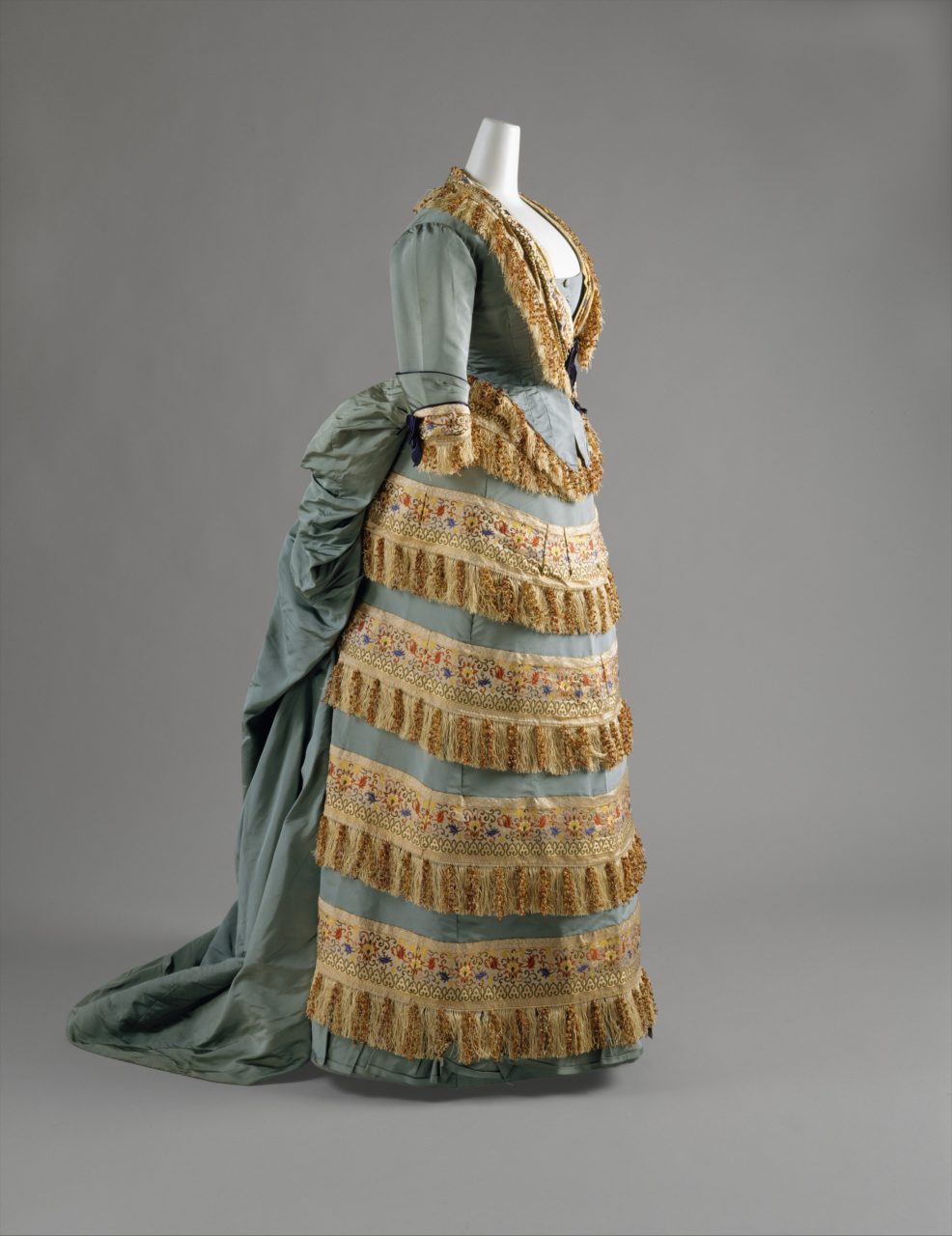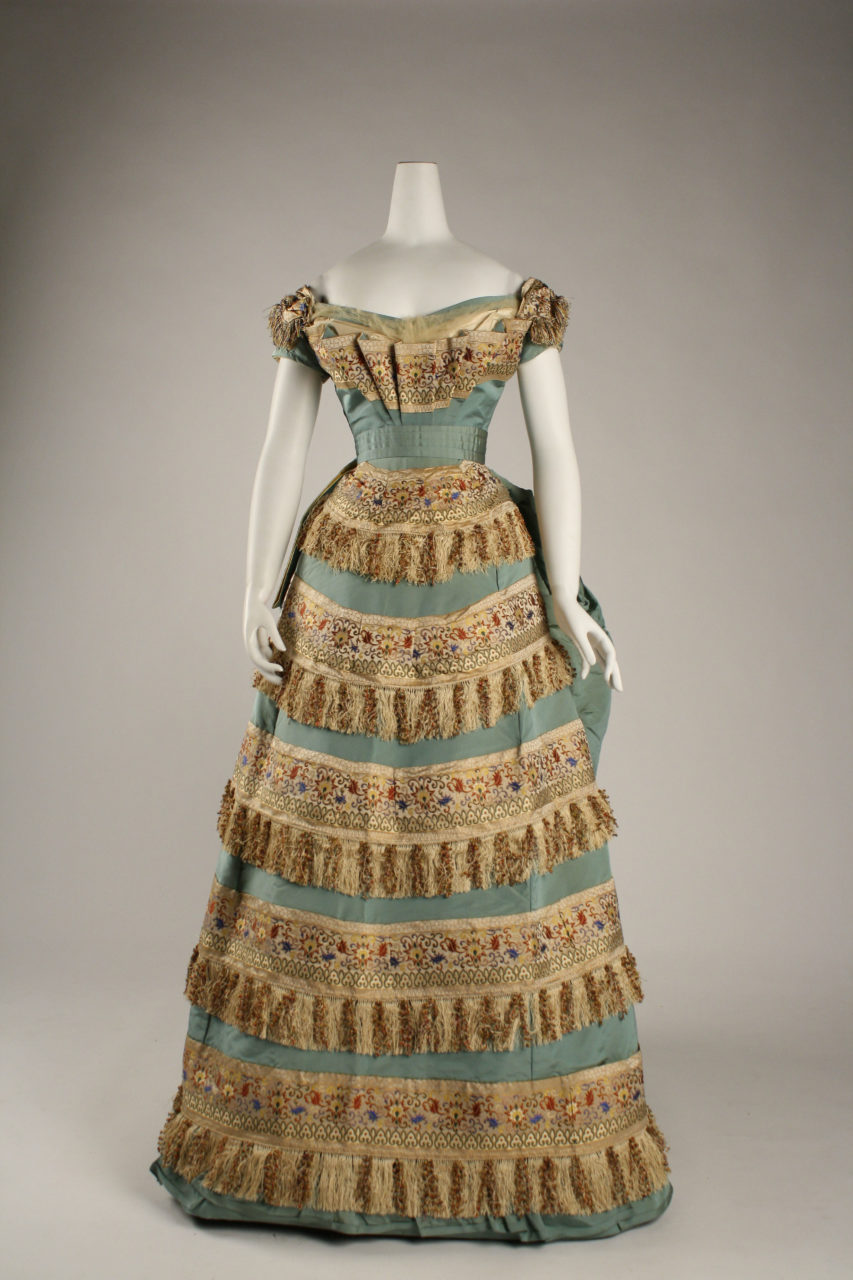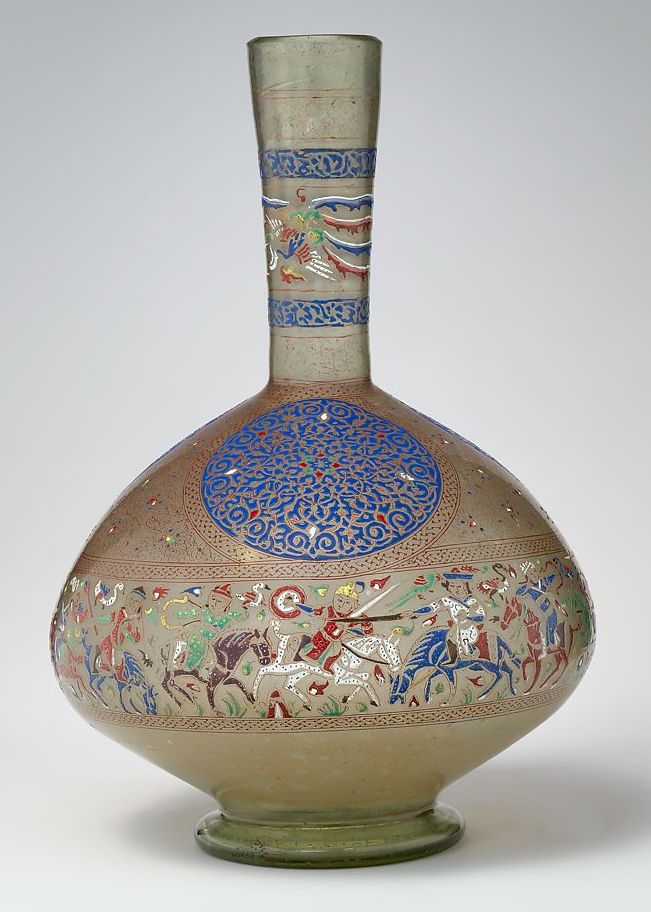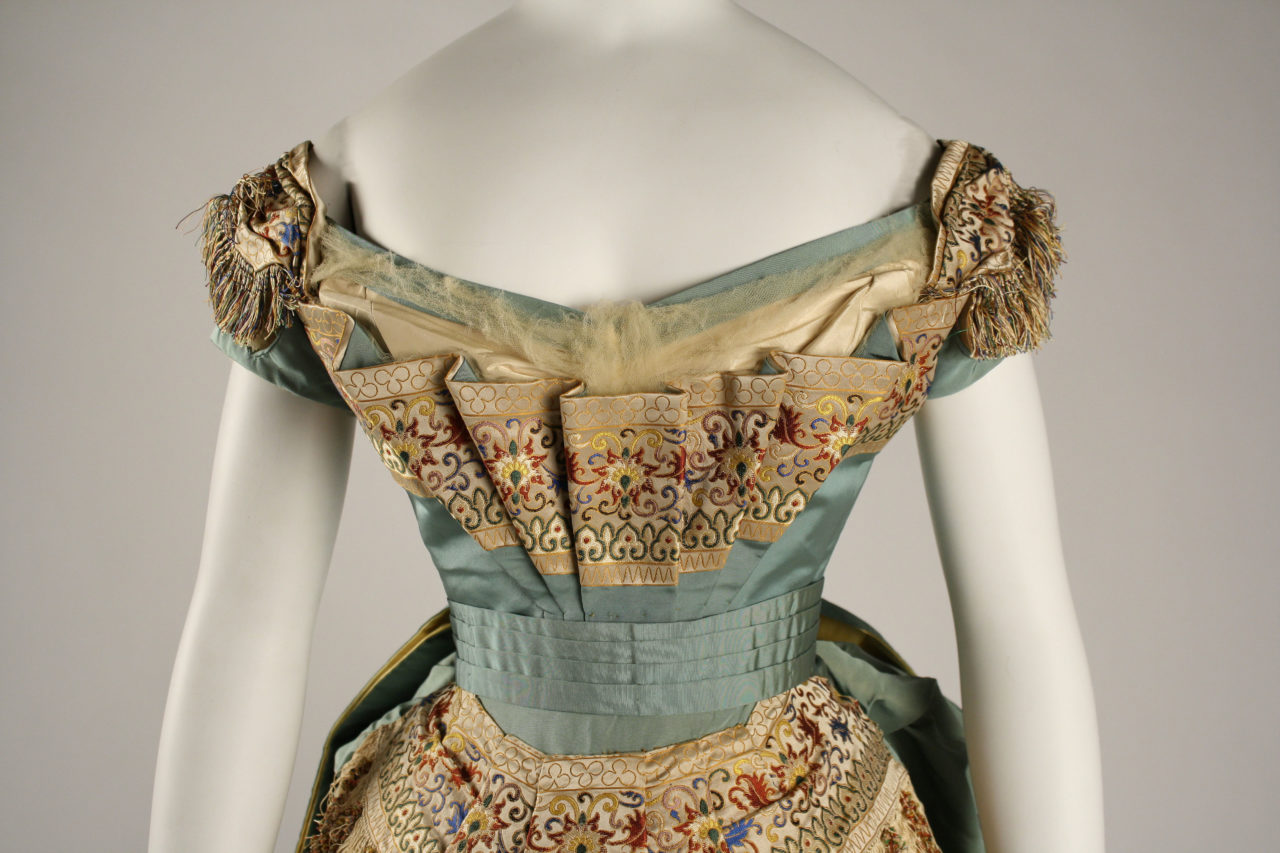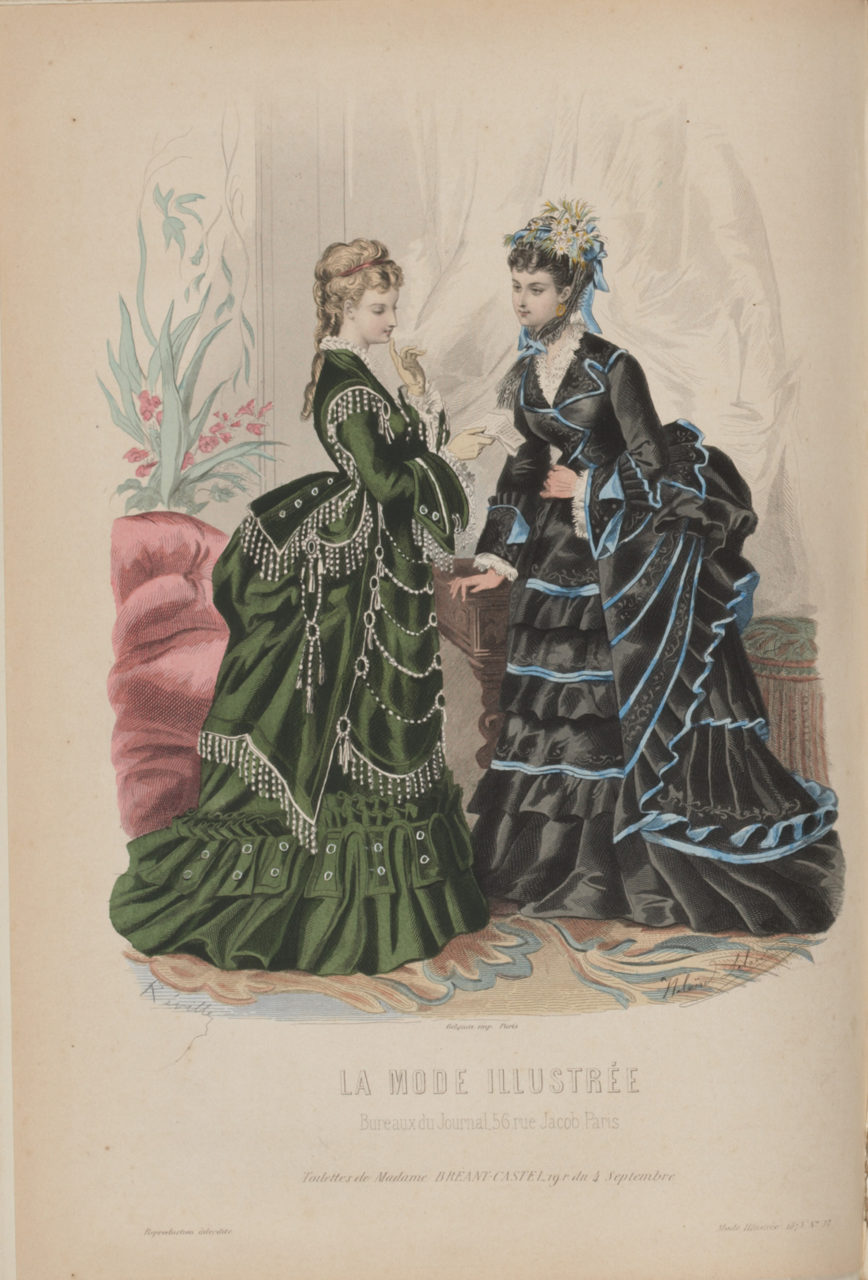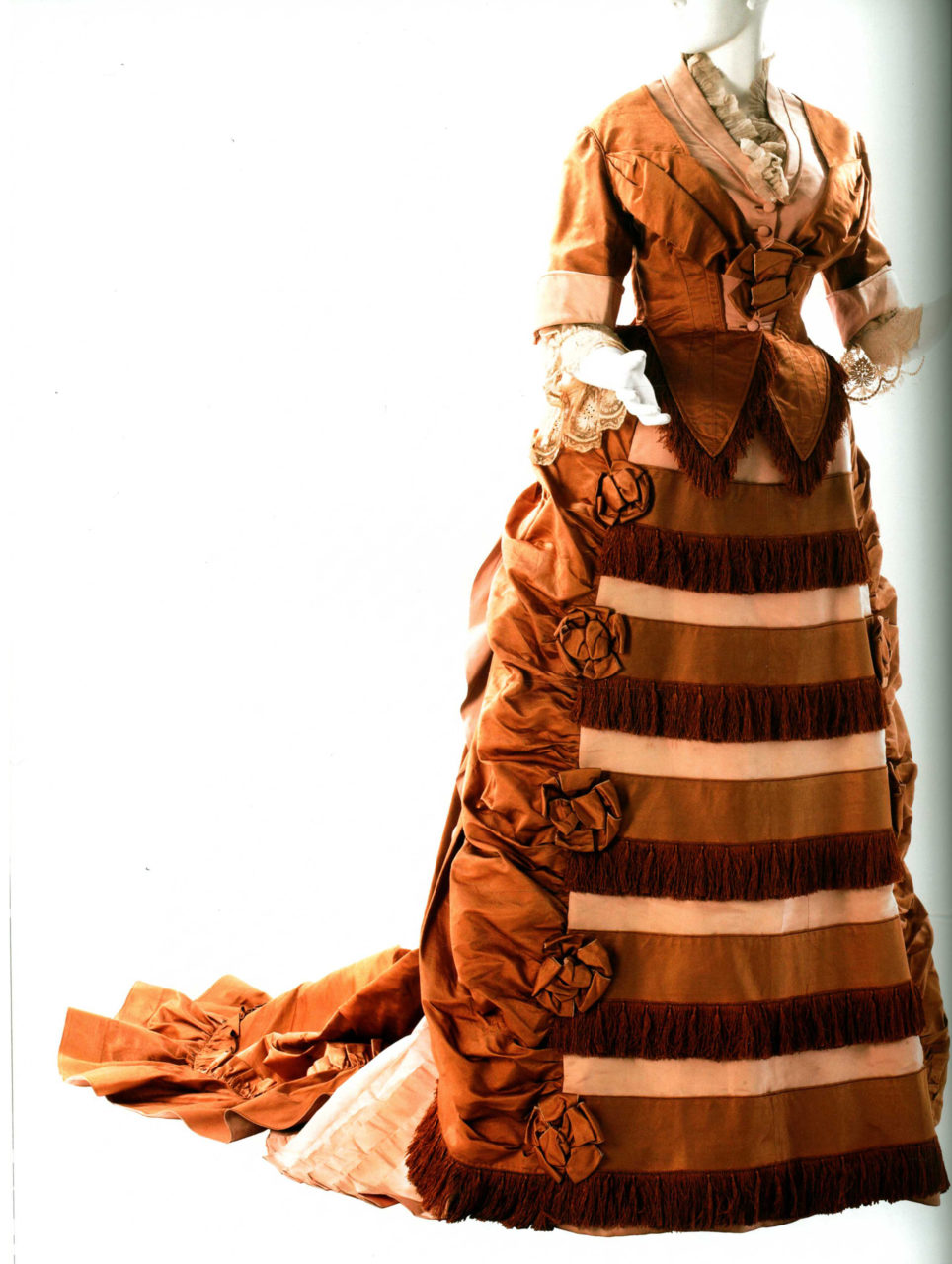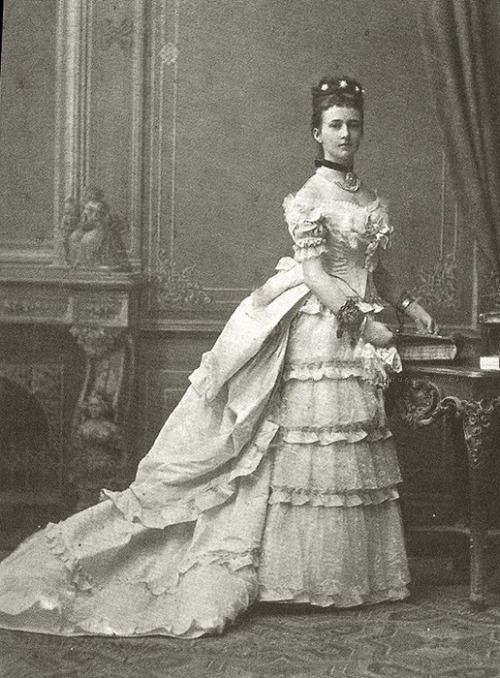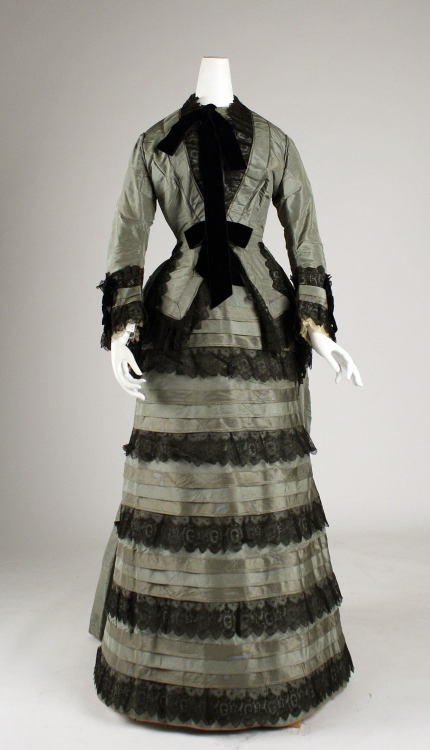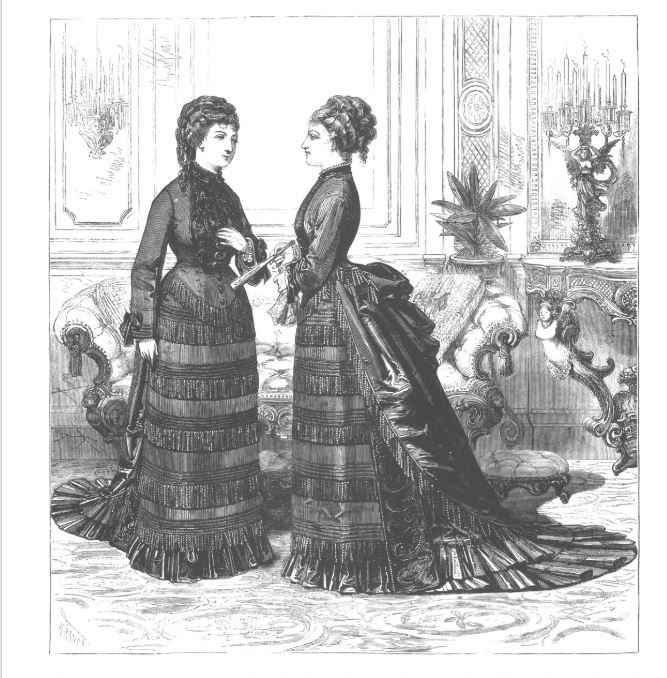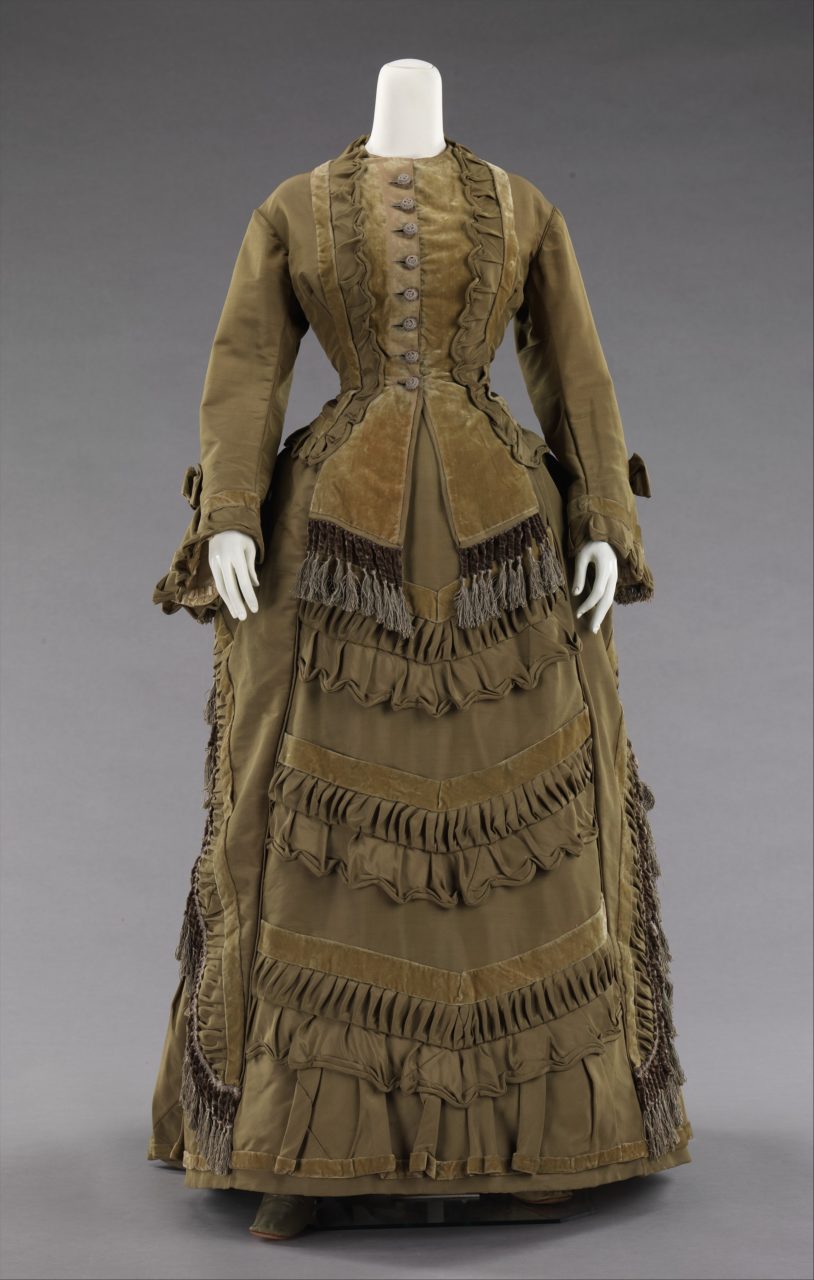This 1872 Worth dress reflects dominant trends of the moment with its use of fringe, bows and horizontal trim, but is also somewhat more unique in its use of Islamic enamel-inspired ribbons.
About the Look
This gown, designed by French fashion designer Charles Frederick Worth, is made of seafoam green silk with woven braids and fringe trims. This dress consists of a skirt and two bodices; one for daytime and another for evening occasions. The day bodice (Figs. 1, 3) has three-quarter length sleeves with square neckline, self-covered buttons, and a dark purple ribbon and fringe trims, whereas the evening bodice (Figs. 2, 6) has a portrait neckline decorated with distinctive pleats and gathered tulle.
The bustle silhouette is straight in the front with soft drapery volume on the back (Fig. 3). The woven braid and fringe trims are placed on the front of the skirt horizontally as well as along with the neckline, sleeves, and bottom edge of the day bodice. The embroidery on the trim features diverse colors and a gold thread (Fig. 4). Based on pattern of the woven braid, the Metropolitan Museum of Art states that:
“Worth rarely scrutinized or adapted forms from the East; in this unusual example, he has emulated Middle Eastern enamels.”
See, for example, an enameled and gilded bottle from the 13th century (Fig. 5), which shares a similar color palette and floriate motifs. The evening bodice makes dramatic use of the ribbon in fan pleats across the bust, which is filled in with swathes of satin and tulle fabric (Fig. 6).
The dress includes a label, seen in figure 7, marking this as a Worth gown and includes the address of his couture house in Paris (7, rue de la Pais). Worth is thought to be one of the first designers to have his own labels sewn into clothes he designed (De Marly).
Fig. 1 - Charles Frederick Worth (French, 1825–1895). Day bodice, side view, 1872. Silk. New York: The Metropolitan Museum of Art, 46.25.1a–d. Gift of Mrs. Philip K. Rhinelander, 1946. Source: The Met
Fig. 2 - Charles Frederick Worth (French, 1825–1895). Ball gown, 1872. Silk. New York: The Metropolitan Museum of Art, 46.25.1a–d. Gift of Mrs. Philip K. Rhinelander, 1946. Source: The Met
Fig. 3 - Charles Frederick Worth (French, 1825–1895). Day bodice and skirt, rear view, 1872. Silk. New York: The Metropolitan Museum of Art, 46.25.1a–d. Gift of Mrs. Philip K. Rhinelander, 1946. Source: The Met
Fig. 4 - Charles Frederick Worth (French, 1825–1895). Ribbon and fringe detail, 1872. Silk. New York: The Metropolitan Museum of Art, 46.25.1a–d. Gift of Mrs. Philip K. Rhinelander, 1946. Source: The Met
Fig. 5 - Artist unknown (Attributed to Egypt, possibly Cairo). Enameled and Gilded Bottle, late 13th century. Glass, greenish; blown, folded foot; enameled and gilded; 43.5 x 27.9 cm (17 1/8 x 11 in). New York: The Metropolitan Museum of Art, 41.150. Rogers Fund, 1941. Source: The Met
Fig. 6 - Charles Frederick Worth (French, 1825–1895). Evening bodice, 1872. Silk. New York: The Metropolitan Museum of Art, 46.25.1a–d. Gift of Mrs. Philip K. Rhinelander, 1946. Source: The Met
Fig. 7 - Charles Frederick Worth (French, 1825–1895). Ball gown, 1872. Silk. New York: The Metropolitan Museum of Art, 46.25.1a–d. Gift of Mrs. Philip K. Rhinelander, 1946. Source: The Met
Charles Frederick Worth (French, 1825–1895). Day bodice and skirt, 1872. Silk. New York: The Metropolitan Museum of Art, 46.25.1a–d. Gift of Mrs. Philip K. Rhinelander, 1946. Source: The Metropolitan Museum of Art
About the context
The elegant details of this dress are indicative of the work of Charles Frederick Worth, who is often called the father of haute couture (De Marly). This dress skillfully mixes popular color choices with cutting edge design details like horizontal trimming that will soon dominate Parisian fashion.
Harper’s Bazar describes Worth’s collection in an issue from November 23, 1872:
“A fresh importation of costumes from Worth’s and Pingat’s shows some new fancies not yet chronicled, and revives some quaint old styles. Two-thirds of this importation are of black dresses, failles of superb texture, black velvet garments, and black camel’s hair; the remaining third is of the prevalent bronze and olive shades.” (763)
Fashion plates and extant dresses (Figs. 8, 9, 12, 15) attest to how many diverse green shades were used at the time–from olive to hunter to seafoam.
Fig. 8 - Jules David (French, 1808-1892). Le Moniteur de la Mode, vol. 2, no. 2 (November 1872). New York: The Metropolitan Museum of Art, b17509853. Source: The Met Digital Collections
Fig. 9 - Hélöise Leloir (French, 1820-1873). La Mode illustrée, no. 57 (September 1873): pl. 37. Tokyo: Bunka Gakuen Library. Toilettes de Madame BREANT-CASTEL 19. r. du 4 Septembre. Source: Bunka Gakuen
Fig. 10 - Charles Frederick Worth (French, 1825-1895). Afternoon dress, 1873. Silk. Trubert-Tollu, C., Tétart-Vittu, F., Martin-Hattemberg, J.-M., Olivieri, F., & Lacroix, C. (2017).. Source: The House of Worth, 1858-1954: The Birth of Haute Couture, p. 108
Fashions were changing in the early 1870s, as the crinolined skirt silhouette popular during the 1860s narrowed with the volume of the skirt now in the back. Figure 8, like the Worth gown, displays the newer, more slender style. Even though the front is straight and flat, the back has decorative drapery that exaggerates a woman’s backside.
Worth was known for popularizing trends. The “fancies” cited in the Harper’s Bazar quotation above may be in reference to adornments like his use of fringe. Fashion plates of the time frequntly feature fringe and trims over the entire dress as fringe had become one of the more fashionable trims of the era. Godey’s Magazine’s ‘Chitchat’ in October 1870 notes its rise:
“Satin has lost its popularity for trimming; A suit elaborately trimmed with satin now looks old fashioned. It is still used a little for narrow pipings. Velvet has taken its place; Fringes of all widths, quilled ribbons, gimps, passementeries, and all imported trimmings are more used than for a year past.” (388)
Worth’s choice to employ horizontal trim details across the front of the skirt, as seen also in figure 8, became extremely popular circa 1872.
An 1873 La Mode illustrée fashion plate (Fig. 9) and an 1873 bronze-colored dress (Fig. 10), also designed by Worth, employ the same horizontal trim details. In the early 1870s, we also see the Infanta Maria Jose of Portugal (Fig. 11) wearing a pale ball gown with an off-shoulder neckline and apparent horizontal trim line on the front.
Two other surviving early 1870s dresses (Figs. 12-13) resemble Worth’s dress with their use of horizontal ribbon trim across the skirt with matching trim at the neckline and cuffs, as well as bow details. Although these dresses use lace rather than fringe trim, their design details and overall effect are akin to Worth’s dress.
Fig. 13 - Designer unknown. Gray day dress with horizontal trims, 1870s. Silk. Source: Tumblr
Fig. 14 - Artist unknown. Harper's Bazar, vol. 7, no. 51 (December 1874): 829. New York. Source: Cornell
Fig. 15 - Designer unknown (American). Ensemble, ca. 1875. Silk, cotton, glass. New York: The Metropolitan Museum of Art, 2009.300.1454a–e. Brooklyn Museum Costume Collection at The Metropolitan Museum of Art, Gift of the Brooklyn Museum, 2009; Gift of Theodora Hay, 1952. Source: The Met
In February 1874, Harper’s Bazar published an article profiling Worth, exclaiming that “the materials and designs he furnishes are first-class and original” (117). A black and white fashion plate (Fig. 14) from Harper’s Bazar that same year–two years after the creation of Worth’s dress–still show horizontal trimmings. An olive velvet dress made in America the next year (Fig. 15) demonstrates the continuing popularity of the design elements we’ve seen from the bustle silhouette and green hue to the fringe trim, horizontally applied to the front.
Thus the 1872 Worth dress in the Met’s collection reflects dominant trends of the moment with its use of fringe, bows and horizontal trim, but is also somewhat more unique in its use of Islamic enamel-inspired ribbons.
References:
- “Ball gown, ca. 1872.” The Metropolitan Museum of Art. Accessed March 2020. https://www.metmuseum.org/art/collection/search/80002258
- De Marly, Diana. Worth: Father of Haute Couture. New York: Holmes & Meier, 1990. http://www.worldcat.org/oclc/21599802
- Godey, Louis Antoine, and Sarah Josepha Buell Hale, eds. “Chitchat”, Godey’s Lady’s Book and Magazine, vol. 80–81, no. 484 (October 1870): 387-388. https://babel.hathitrust.org/cgi/pt?id=mdp.39015027389348
- “New York Fashions,” Harper’s Bazar, vol 1, no. 12 (January 18, 1868): 179 https://libproxy.fitsuny.edu:2818/docview/1914160461?accountid=27253
- “New York Fashions,” Harper’s Bazar, vol 5, no. 47 (November 23, 1872): 763. https://libproxy.fitsuny.edu:2818/docview/1850144135/467999180C4342D7PQ/29?accountid=27253
- Trubert-Tollu, Chantal, Françoise Tétart-Vittu, Jean-Marie Martin-Hattemberg, Fabrice Olivieri, and Christian Lacroix. 2017. The House of Worth, 1858-1954: The Birth of Haute Couture. London: Thames & Hudson, 2017. http://www.worldcat.org/oclc/1021185462
- “Worth, The Paris Dressmaker.” Harper’s Bazar vol. 7, no. 7 (February 14, 1874): 116-117. https://www.proquest.com/magazines/worth-paris-dressmaker/docview/1891034464/se-2?accountid=27253.


